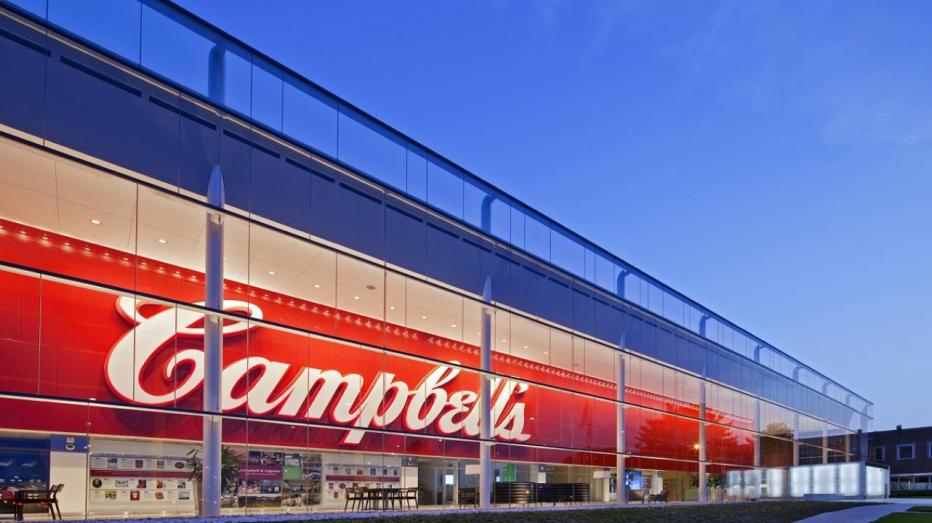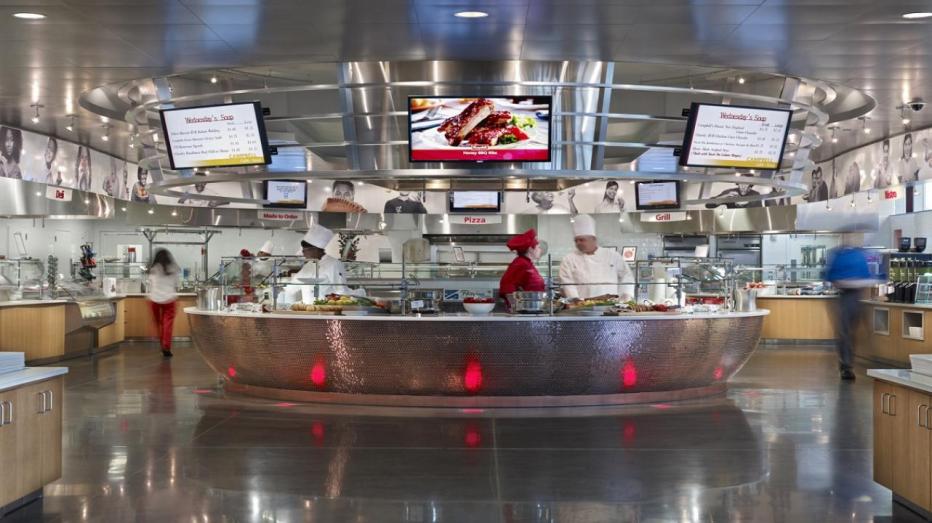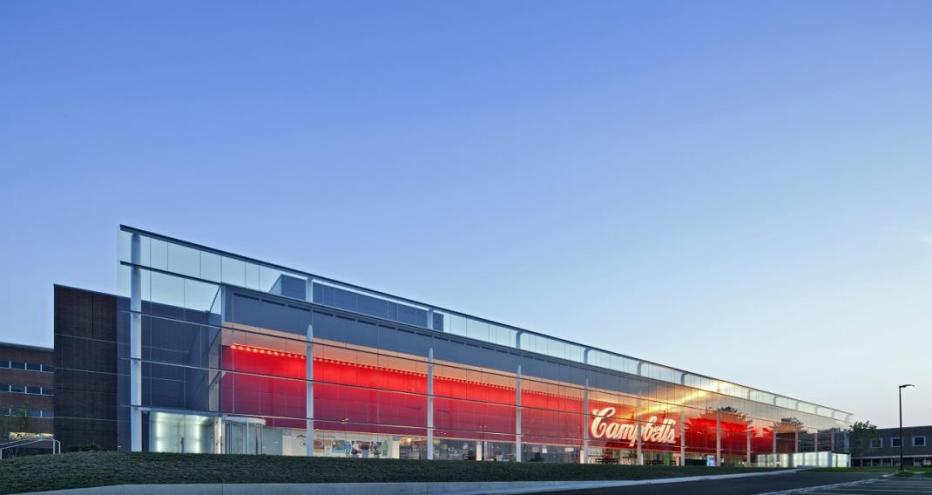
Campbell's Soup Company
In 2006, Campbell Soup Company embarked on an ambitious program known as “The New Face of Campbell’s.” This program focused on revitalizing the Camden, New Jersey campus. Responding to the design competition organized by Campbell, Jacobs embraced the challenge of designing the campus, determined to create an emblem of revitalization.
Our in-house multi-discipline team of architects, engineers, landscape architects, interior designers and workplace strategists to collaborated on a design that combined their best efforts.
Re-invention
The first element of the New Face of Campbell’s project was the design of the new Campbell Employee Center which houses a multitude of campus amenities including the cafeteria, Campbell University Training Center, fitness center, employee store, credit union, etc.
The second major element was the re-invention of the workplace to be more consistent with current work styles and business demands, followed by a multi-phase renovation of existing campus buildings to implement the strategies developed.
-
150 K
square feet or more of campus renovations, with 750,000 square feet of office, research and development and training space
-
250
foot long, 30-foot high “branding wall” in new Employee Center
-
40
acre corporate campus, with buildings designed to reduce the company’s water usage by 45%
-
11
different soups served daily in the new state-of-the-art café’s custom soup bar centerpiece

Campbell's Soup Company
A lasting strategic partnership
The Employee Center (Amenities Building)
The 100,000 square-foot Employee Center highlights the world headquarters while welcoming visitors to the corporate campus. The basis for the design was to create a contemporary professional environment that maximized the use of space, supported changing work processes, and was flexible to respond to the current and future needs of the company.
It features a dramatic lobby with an integrated brand approach highlighting a 250-foot-long, 30-foot-high branding wall that stands behind a two-story glass entrance. The branding wall is super graphic with the Campbell logo that can be seen from the nearby highway.
The Center consists of two levels and a partial lower level. The spirit of the employee is represented on the main level, which houses a cafeteria, servery, kitchen, employee store, as well as the lobby/reception area and security central, encouraging employee interaction and community. Representing the commitment to challenge and stimulate the employee’s mind, the Campbell University learning and development center and office space are incorporated into the upper level.
The 7,500-square-foot health and fitness center promotes the physical health of the employee, and storage areas are located on the lower level.
An integral part of the expansion is a redesigned, state-of-the-art cafeteria that features a soup bar as a multimedia centerpiece. The cafeteria has a large seating area with furniture that is movable for presentations and exhibition cooking.
The central location of the Employee Center creates a unique opportunity to unify the current campus by improving the surrounding grounds. Serving as connectors to various buildings, the exterior plaza provides additional space for dining, large gathering areas for formal and informal occasions, and presentation spots. The inner café/dining area, which also doubles as a location for larger staff meetings and receptions, opens to an outdoor dining terrace. In total, the outside plaza space more than doubles the capacity of the interior cafeteria. Winding paths are lined with benches around the edges of the Wi-Fi compatible courtyard, allowing employees and visitors to meet and work outdoors. The layout of the courtyard creates a seamless flow from within the new building to the plaza area, steps away from the cafeteria and offices.
Phased Renovations of the Headquarters Building and the Building 70
As a continuation of the renewal of the Campbell Soup Company’s World Headquarters Campus, Jacobs developed a master plan for the phased renovation of the 400,000-square-foot main office complex (WHQ) incorporating the new workplace standards developed in the Office Pilot Project. The renovations on the first and second floors have been completed to date.
Following the principles developed earlier during the Workplace Strategy Study, renovation of existing office buildings served as a catalyst for key advancements in Workplace design, redefining workspace and employee working environments.
The implementation of the strategy in the WHQ and Building 70 included three main concepts: daylight for all, increased collaboration space, and flexibility. Reducing the height of workstation panels and increasing glazing in workstations, office fronts and conference rooms increased the sense of openness and contributed to spontaneous interaction and collaboration.
Flexibility was achieved with the integration of sliding walls in conference rooms for “all-hands meetings,” mobile furniture within the workstations, and conference rooms. Jacobs also developed multiple space types within the space “tool kit” such as flexible meeting spaces and huddle rooms which gave employees the opportunity to choose where to work.
Access to daylight and exterior views was a criterion set early on for the new workplace environments so every neighborhood workspace has access to windows and when necessary, it is supplemented by new skylights that have been added in the concrete.
Workplace Strategies and Implementation
The New Face of Campbell’s Workplace was envisioned as an opportunity to identify appropriate workplace solutions that would support the organization in recruiting and retaining the best talent available while giving the organization the best work tools possible.
We embarked on a process of imagining, research, and data generation to inform the new workplace solution by working closely with Campbell’s stakeholder groups. Based on surveys, discussions, research, and observation four priorities were identified for specific attention in the workplace master plan – the number, size, and distribution of conference and meeting spaces; improved acoustical performance; improved access to daylight and views; and a new overall aesthetic expressing the New Face of Campbell’s.
Before new workplace recommendations were finalized, the concepts were implemented in a pilot space located on the second floor of the Employee Center. Three groups including Organizational Effectiveness, Global Talent Acquisition, and Diversity and Inclusion were chosen to occupy the approximately 8,000-square-foot space. The pilot was used as a testing laboratory for many of the concepts recommended by the Working Group. This allowed the team to refine and fine-tune recommendations before the implementation of the plan on the entire campus. Specific items that were looked at in the pilot included: planning concepts, ratios of space types to the number of occupants, furniture solutions, technology solutions, acoustical solutions, and aesthetics.

Campbell's Soup Company
Sustainable Design
The new Employee Center is LEED Silver NC-Certified, making the structure and its construction energy-efficient and ecologically- friendly. It employs energy-efficient HVAC, water conservation, recycled building materials, and daylight harvesting among other sustainable features. This recognition of the environment reflects Campbell’s principles and beliefs and positions the Campbell Soup Company as a steward of sustainable design.
Successful Project Management
The team of experts in the design of forward-thinking office workplace environments working closely with Campbell’s leadership and stakeholder groups was the key to the success of this project. The team leadership and technical resources, particularly when working with multiple stakeholders and projects, required a strong oversight, day-to-day management of the internal project team and consultants, and a wide array of tools to keep the tasks on schedule, on budget, and fully responsive to quality concerns.
Our project controls personnel was actively engaged with the entire project team, getting involved in the design effort, assisting in identifying and resolving obstacles and risks, analyzing data and reporting what happened, and forecasting the future.
Similarly, the quality of work was continuously measured and analyzed to ensure project objectives were met and opportunities for preventive action are identified and addressed. If deviations in work quality were identified, corrective actions were taken. Jacobs’ Quality Assurance Program guides this process throughout all phases of project execution. This process brings significant value to our clients, like Campbell’s, by providing high-quality services, reduced project costs, and reduced schedule risk.














































